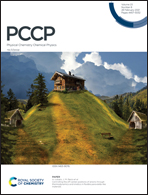Quasi-one dimensional magnetic interactions in the three-dimensional hyper-honeycomb framework [(C2H5)3NH]2Cu2(C2O4)3
Abstract
The Cu(II) ions in [(C2H5)3NH]2Cu2(C2O4)3 form a hyperhoneycomb lattice and show no indication of long-range magnetic order down to 60 mK. It has therefore been suggested that [(C2H5)3NH]2Cu2(C2O4)3 is a three dimensional quantum spin liquid. We construct a tight-binding model of [(C2H5)3NH]2Cu2(C2O4)3 from Wannier orbital overlaps. Including interactions within the Jahn–Teller distorted Cu-centered eg Wannier orbitals leads to a highly anisotropic effective Heisenberg model. We show that this anisotropy arrises from interference between different superexchange pathways. This demonstrates that when two (or more) orbitals contribute to the localised spin superexchange can be significantly richer than in the textbook single orbital case. The hyper-honeycomb lattice contains two symmetry distinct sublattices of Cu atoms arranged in coupled chains. We show that one sublattice is strongly dimerized, the other forms isotropic antiferromagnetic chains. Integrating out the strongest (intradimer) exchange interactions leaves extremely weakly coupled Heisenberg chains.
![Graphical abstract: Quasi-one dimensional magnetic interactions in the three-dimensional hyper-honeycomb framework [(C2H5)3NH]2Cu2(C2O4)3](/en/Image/Get?imageInfo.ImageType=GA&imageInfo.ImageIdentifier.ManuscriptID=D0CP05999D&imageInfo.ImageIdentifier.Year=2021)


 Please wait while we load your content...
Please wait while we load your content...